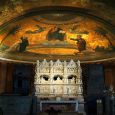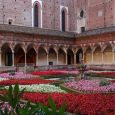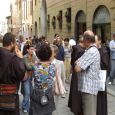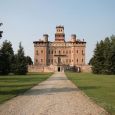Pavia
Advertisement
By Air
The closest airports are in Milan Milano Linate (LIN), smaller but easier to reach or Milano Malpensa (MXP).Also Orio al Serio (BGY) is usually included in the Milan area airports (MIL) but we don't suggest to use it because difficult to reach.A taxi from any airport to Pavia will cost you about 80 Euros ask the driver before you take it.From Linate it could be convenient to take a taxi to Milano Centrale railway station and then continue by train to Pavia.A shuttle also links Linate with the station it is cheaper and comfortable.It leaves just in front of the domestic arrival terminal every 20 minutes or so the trip lasts about half an hour.
By Train
Pavia railway station opened in 1862 forms part of the Milan–Pavia–Voghera railway and is also a terminus of four secondary railways linking Pavia with Alessandria, Cremona, Vercelli and Stradella.
By Road
The closest highway is the A7 Milano-Genova.Take exit Bereguardo (Pavia Nord) and follow the signs to Pavia.If you are traveling on A21 Torino-Piacenza coming from East (from Piacenza) you can use exit Broni-Stradella and follow the signs to Pavia if you are coming from West (from Torino) take A7 North (to Milano) in Tortona and exit in Bereguardo.If you are coming via the A1 Milano-Bologna (direction North) you can either use exit Casalpusterlengo and follow the signs to Pavia or take A21 West (to Torino) in Piacenza (this second possibility is longer but preferable in case of trafic jams or fog).
Advertisement
Basilica of San Michele Maggiore
a masterpiece of Romanesque Lombard is a church of Pavia dating back to centuries XI and XII.The first church dedicated to St. Michael the Archangel was originally built at the chapel of the Royal Palace in the Lombard period thanks to the monks of St. Columbanus of Bobbio (this period was the bottom of the bell ) but was destroyed by fire in 1004.The present building began around the end of the eleventh century (which date back to the crypt, the choir and transepts) and was completed in 1155 (with a break due to the great earthquake of January 3, 1117 ).The times of the nave central, originally composed of two spans roughly square cross (or, according to some historians vaulted domed basilicas of the model of Roman- Byzantine as San Marco in Venice ) were rebuilt in 1489 by Augustine from Heraklion with a rectangular pattern of four bays, such as to ensure a better static efficiency of the architectural complex.The facade has a gabled linear profile enhanced by a loggia along the slopes of twenty-two arches.The counters are made of vertical piers that mark the surface.On the façade there are five small mullioned windows three single-light windows and a cross between two bull's eyes.This provision is a reconstruction of the nineteenth century up to that time, there was in fact a large circular window certainly not original just removed to restore the facade to the original configuration.There are horizontal bands carved in low relief depicting plots of humans, animals and monsters.
Pavia Cathedral
is a church in Pavia, northern Italy, the largest in the city. The construction (presently still unfinished in some minor details) was begun in the 15th century on the site of two pre-existing Romanesque cathedrals (Santo Stefano and Santa Maria del Popolo). The cathedral houses the remains of St. Sirus, first bishop of Pavia. Next to the cathedral was the Civic Tower (Torre Civica), known in 1330 and enlarged in 1583, which crumbled down on March 17 1989.The church is on the Greek Cross plan: it therefore has the same length and width at the transept (c. 84 m). Such size makes it one of the largest edifices with central plan in northern Italy.The central dome, with an octagonal plan, is 97 m tall, with a total weight of some 20,000 tons. It is the fourth in Italy in size, after St. Peter's, the Pantheon and Florence Cathedral.
Visconti Castle
was built in 1360 by Galeazzo II Visconti.The castle park originally stretched for about ten kilometers to the Certosa di Pavia, now part of the park is still there, but no longer connected to the castle, and called the Park Vernavola.The castle houses the Civic Pinacoteca Malaspina.In recent years the castle are organized several exhibitions, and during the summer including concerts in his small garden.
Pavia Covered Bridge
is a bridge over the river Ticino at Pavia, which connects the old city center (located on the left bank of the Ticino), with the picturesque district, originally outside the walls of the outlying towns of Borgo Ticino.The bridge is quaint, with five arches and completely covered with two portals at each end and a chapel in the center.Although the current bridge was built in 1949, it presents the type of the old Covered Bridge, dating from the fourteenth century.Already in Roman times, the ancient city of Ticinum first there was a bridge connecting the two banks of the river at the modern Covered Bridge. Of this bridge is easily seen in the lean periods, the base of a central pier in trachyte Euganean Hills. The direction of the pylon (SSE), slightly offset from those of medieval and modern bridges, indicates that in Roman times the current direction of the river was different. Another pillar of the Roman bridge could be seen until a few years ago at the left bank, but was covered with earth to expand the bank. The construction of the Roman bridge is dated at the time of Augustus.
San Pietro in Ciel d Oro
is a Roman Catholic basilica (and a former cathedral) of the Augustinians in Pavia, Italy, in the Lombardy region. Its name refers to the mosaics of gold leaf behind glass tesserae that formerly decorated the ceiling of the apse. The plain exterior is of brick, with sandstone quoins and window framing. The paving of the church floor is now lower than the modern street level of Piazza Dante, which lies before its facade.A church of Saint Peter is recorded in Pavia in 604; it was renovated by Liutprand, King of the Lombards (who is buried here) between 720 and 725. The present Romanesque church was consecrated by Pope Innocent II in 1132.The church is the resting place for the remains of Augustine of Hippo, who died in 430 in his home diocese of Hippo Regius, and was buried in the cathedral there, during the time of the Vandals. According to Bede's True Martyrology, the body was removed to Cagliari, Sardinia by the Catholic bishops whom the Arian Vandal Huneric had expelled from north Africa. Bede tells that the remains were subsequently redeemed out of the hands of the Saracens there— by Peter, bishop of Pavia and uncle of the Lombard king Liutprand— and deposited in the church of Saint Peter about the year 720.
Santa Maria del Carmine
is a church in Pavia, Lombardy, northern Italy, considered amongst the best examples of Lombard Gothic architecture.It was begun in 1374 by Gian Galeazzo Visconti, Duke of Milan on a project attributed to Bernardo da Venezia.The construction followed a slow pace and was restarted in 1432, being finished in 1461.The church has an imposing facade commanding the square with the same name; the slender forms betray a residual Romanesque influence although the decorations are undoubutably of Lombard Gothic style.The facade is divided into five vertical compartments by six pilasters surmounted by spires.The three central sectors have a portal each remade by Giuseppe Marchesi in 1854.Over the portals are four large ogival mullioned windows and an elaborated rose window in brickwork.The bell tower dating to c. 1450 has numerous friezes and a triple mullioned window with marble columns.
October - December
February - June
Information not available
Advertisement








